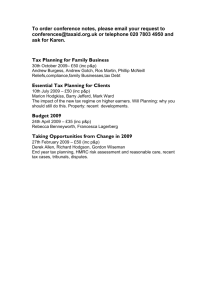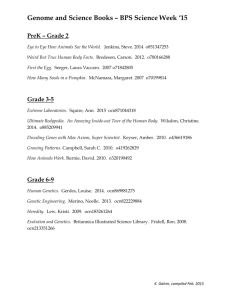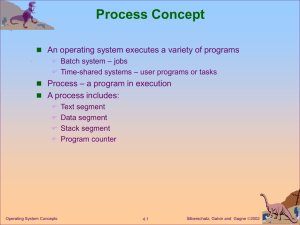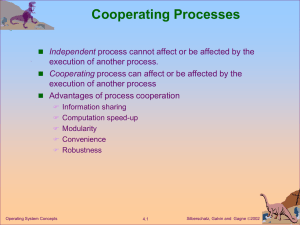Process Concept Process Creation Process Termination
advertisement
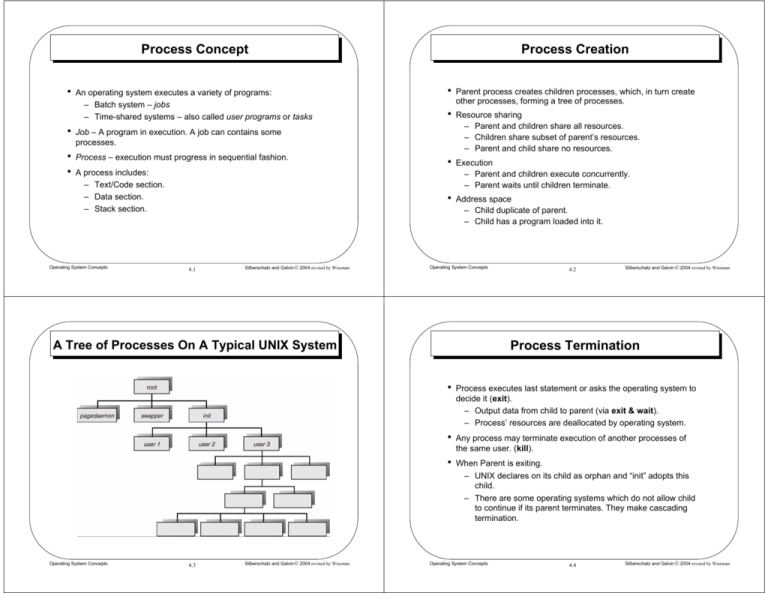
Process Concept • An operating system executes a variety of programs: – Batch system – jobs – Time-shared systems – also called user programs or tasks • Job – A program in execution. A job can contains some processes. • • Process – execution must progress in sequential fashion. A process includes: – Text/Code section. – Data section. – Stack section. Operating System Concepts 4.1 Silberschatz and Galvin 2004 revised by Wiseman Process Creation • Parent process creates children processes, which, in turn create other processes, forming a tree of processes. • Resource sharing – Parent and children share all resources. – Children share subset of parent’s resources. – Parent and child share no resources. • Execution – Parent and children execute concurrently. – Parent waits until children terminate. • Address space – Child duplicate of parent. – Child has a program loaded into it. Operating System Concepts 4.3 Silberschatz and Galvin 2004 revised by Wiseman Silberschatz and Galvin 2004 revised by Wiseman Process Termination A Tree of Processes On A Typical UNIX System Operating System Concepts 4.2 • Process executes last statement or asks the operating system to decide it (exit). – Output data from child to parent (via exit & wait). – Process’ resources are deallocated by operating system. • Any process may terminate execution of another processes of the same user. (kill). • When Parent is exiting. – UNIX declares on its child as orphan and “init” adopts this child. – There are some operating systems which do not allow child to continue if its parent terminates. They make cascading termination. Operating System Concepts 4.4 Silberschatz and Galvin 2004 revised by Wiseman Process State (Not in Unix) • Diagram of Process State As a process executes, it changes state – new: The process is being created. – running: Instructions are being executed. – waiting: The process is waiting for some event to occur. – ready: The process is waiting to be assigned to a process. – terminated: The process has finished execution. Operating System Concepts 4.5 Silberschatz and Galvin 2004 revised by Wiseman Operating System Concepts Process State in Linux • • • • • 4.6 Process Control Block (PCB) R running or ready. Information associated with each process. S sleeping (=waiting). • • • • • • • • T Stopped. Z a defunct ("zombie") process. D uninterruptible sleep (IO). Operating System Concepts 4.7 Silberschatz and Galvin 2004 revised by Wiseman Silberschatz and Galvin 2004 revised by Wiseman Process state Process number Program counter CPU registers CPU scheduling information Memory-management information Accounting information I/O information (open files) Operating System Concepts 4.8 Silberschatz and Galvin 2004 revised by Wiseman CPU Switch From Process to Process Operating System Concepts 4.9 Silberschatz and Galvin 2004 revised by Wiseman Ready Queue And Various I/O Device Queues Operating System Concepts 4.11 Silberschatz and Galvin 2004 revised by Wiseman Process Scheduling Queues • Ready queue – set of all processes residing in main memory, ready and waiting to execute. • • Device queues – set of processes waiting for an I/O device. Processes migrate between the various queues. Operating System Concepts 4.10 Silberschatz and Galvin 2004 revised by Wiseman Representation of Process Scheduling Operating System Concepts 4.12 Silberschatz and Galvin 2004 revised by Wiseman Schedulers Context Switch • Long-term scheduler (or job scheduler) – selects which processes should be brought into the ready queue. • Short-term scheduler (or CPU scheduler) – selects which process should be executed next and allocates CPU. • • In UNIX the Long-term scheduler does not exist. • Long-term scheduler is invoked very infrequently (seconds, minutes) ⇒ (may be slow). • The long-term scheduler controls the degree of multiprogramming. • Processes can be described as either: – I/O-bound process – spends more time doing I/O than computations, many short CPU bursts. – CPU-bound process – spends more time doing computations; few very long CPU bursts. Short-term scheduler is invoked very frequently (milliseconds) ⇒ (must be fast). Operating System Concepts 4.13 Silberschatz and Galvin 2004 revised by Wiseman Cooperating Processes • Independent process cannot affect or be affected by the execution of another process. • Cooperating process can affect or be affected by the execution of another process • Advantages of process cooperation – Information sharing – Computation speed-up – Modularity Operating System Concepts 4.15 Silberschatz and Galvin 2004 revised by Wiseman • When CPU switches to another process, the system must save the state of the old process and load the saved state for the new process. • Context-switch time is overhead; the system does no useful work while switching. • Time dependent on hardware support. Operating System Concepts 4.14 Silberschatz and Galvin 2004 revised by Wiseman Producer-Consumer - Shared-Memory Solution • Producer process produces information that is consumed by a Consumer process. How to implement? • Shared data var n; type item = … ; var buffer. array [0..n–1] of item; in, out: 0..n–1; • Producer process repeat … produce an item in nextp … while in+1 mod n = out do no-op; buffer [in] :=nextp; in :=in+1 mod n; until false; Operating System Concepts 4.16 Silberschatz and Galvin 2004 revised by Wiseman Bounded-Buffer (Cont.) • Consumer process repeat while in = out do no-op; nextc := buffer [out]; out := out+1 mod n; … consume the item in nextc … until false; • Direct Communication • Processes must name each other explicitly: – send (P, message) – send a message to process P – receive(Q, message) – receive a message from process Q • Properties of communication link – Links are established automatically. – A link is associated with exactly one pair of communicating processes. Solution is correct, but can only fill up n–1 buffer. Operating System Concepts 4.17 Silberschatz and Galvin 2004 revised by Wiseman Operating System Concepts Messages received from the resource itself. – Each resource has a unique id. – Processes can communicate only if they share a resource. • Properties of communication link – Link established only if processes share a common resource. – A link may be associated with many processes. • Operations – create a new resource. – send and receive messages through resource. – destroy a resource. Operating System Concepts 4.19 Silberschatz and Galvin 2004 revised by Wiseman Silberschatz and Galvin 2004 revised by Wiseman Synchronization Indirect Communication • 4.18 • • • • Message passing may be either blocking or non-blocking. Blocking is considered synchronous Non-blocking is considered asynchronous send and receive primitives may be either blocking or nonblocking. Operating System Concepts 4.20 Silberschatz and Galvin 2004 revised by Wiseman Buffering • Queue of messages attached to the link; implemented in one of three ways. 1. Zero capacity – 0 bytes Sender must wait for receiver (rendezvous). 2. Bounded capacity – finite length of n bytes Sender must wait if the link is full. 3. Unbounded capacity – infinite length Sender never waits. • In UNIX there are: – Pipes – Bounded capacity – Messages – Unbounded capacity Operating System Concepts 4.21 Silberschatz and Galvin 2004 revised by Wiseman

